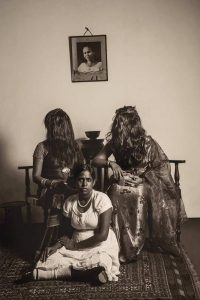Tsuktiben Jamir
We have already caught wind of the opening of the first ever major museum in South Indian called the ‘Museum of Art and Photography’ in the green city of Bengaluru. As a part of the debut exhibition, visitors witnessed the curated walkthrough of ‘Visible/Invisible’ on the 23rd of February, that featured a variety of artworks by contemporary artists including Jamini Roy, Bhupen Khakhar, Mrinalini Mukherjee, Ravinder Reddy, Arpita Singh, and M.F Hussain. Its focus is to highlight the disparity and implications between how women have been portrayed in artworks throughout history, bringing to light everything from kantha stitch needlework in West Bengal to photography portraits like Anoli Perera’s captivating “I Let My Hair Loose” series.
In the Western paintings, we have seen the deceitful seductresses like Delilah during the Baroque period, naked girls being Lust, Truth, or Vanity and other abstract

Courtesy: Anoliperera.com
concepts. Rather than people, portraits made of women to essentially “advertise” them as being of marriageable age, virgin Marys, Orientalist harems, ballet dancers of Degas, prostitutes of Schille Money and Picasso, the inviting Venus of Urbino by Titian, and the arguably more feminist scandalous Olympia by Manet. ‘Visible/Invisible’ seeks to intercept the various ways of how women have been portrayed in the Indian artworks throughout the years.
The publication is divided into four sections that correspond to the exhibition narratives of Goddess and Mortal, Sexuality and Desire, Power and Violence, and Struggle and Resistance. It draws from the collection’s various thematic threads to highlight questions and frameworks in order to broaden the arguments within feminist discourse. Each part is presented contextually by laying forth the larger arguments that surround it, followed by artwork pictures and descriptions that offer reasons and arguments in opposition to those arguments.
Moreover, the exhibition includes quotes, extracts, and poetry that offer contrasting perspectives on the artwork. The main dialectics of this show are outlined in an introduction essay written by the director of MAP, Kamini Sawhney. Shukla Sawant’s article muses on the notion of the woman as a muse and women engaged in the art world in pre-Independent India.
By featuring perspectives that are underrepresented in popular discourses of art history, these pieces express fresh notions about gender and caste. They give a framework to the context of sexual minority groups and behaviours that emphasise the nexus between caste and labour.
An introduction by Kamini Sawhney, director of MAP, and essays by Professor Shukla Sawan, an artist and scholar based in Delhi, Vijeta Kumar, a writer and teacher based in Bangalore, and Arushi Vats, a curator and writer based in Delhi will be included in the 240-page fully illustrated catalogue for the exhibition.
This show is unquestionably an important occasion that will undoubtedly bring together art lovers, collectors, and community members. Overall, the show aims to provide visitors to the Museum of Art and Photography with a thought-provoking and aesthetically fascinating experience.
View this post on Instagram





